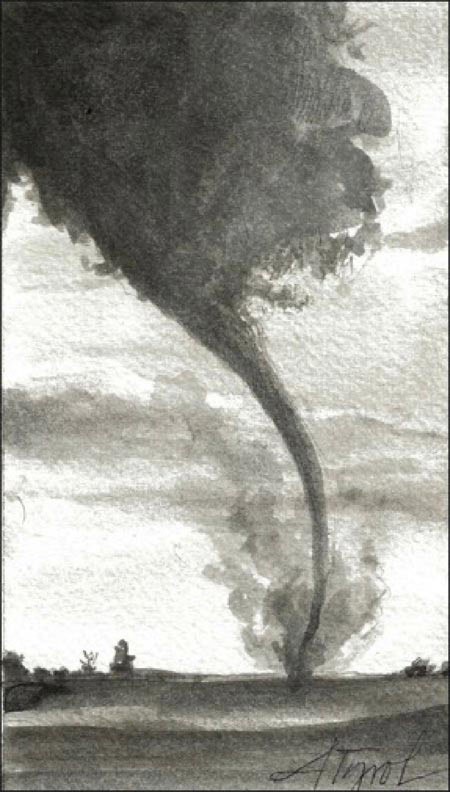
It was a late-May afternoon in central Oklahoma and big time thunderstorms were expected to form soon. I was there as part of a 30-person tornado research team – a Vermont weatherman’s dream-come-true. Our goal? Bring 10 vehicles as close as we safely could to tornadoes to gather meteorological data. The armada consisted of three large flatbed trucks outfitted with Doppler radar arrays able to scan thunderstorms and pinpoint any tornadoes within them. Also in tow were a dozen or so pickup trucks carrying deployable (but very heavy) weather instrument pods that we intended to put in the path of oncoming twisters to directly measure wind.
As we chit-chatted in the searing heat, a team member came over the CB radio to announce that a Tornado Watch had been issued – not for Oklahoma, but for Vermont! Over the next couple of hours, I remained glued to the radar imagery coming in, reveling in the irony that I had come all the way to the Great Plains to witness tornadoes, and now they were happening back on my home turf.
The Vermont storm began as an ordinary thunderstorm, but quickly became severe. Eventually, it transitioned into what is known as a supercell thunderstorm. Supercells are the rarest and most powerful brand of thunderstorm, respected and feared for their ability to produce enormous hail, damaging straight-line winds, rapid-fire lightning, intense rain, and of course, tornadoes. Unlike hurricanes, which can cause corridors of wind damage hundreds of miles across, supercells focus their rage on much smaller areas. Tornadoes are rarely more than a mile wide, but their rotating winds can lash the earth at speeds exceeding 200 mph – fast enough to rip the asphalt from the road.
As the Vermont supercell slowly drifted east-southeast, it exhibited all the telltale signs of strong rotation. Accordingly, the National Weather Service issued a tornado warning, and shortly thereafter the storm produced a brief, weak tornado in West Glover, with estimated winds of about 70 mph. It knocked down about 45 trees and blew over a chimney before it petered out.
While rare, tornadoes do form in the Northeast. Unlike in the Plains, where the spring months tend to carry the highest risk for the dangerous whirls, high summer is the most likely time for them here. During this time of the year, the high sun angle and long days often result in sultry surface temperatures. If the air above this warm layer is cold enough, the atmosphere is unstable and therefore favorable for the strong vertical air currents needed to drive thunderstorms. These updrafts can begin to rotate if the horizontal winds they move up into are strong enough, and/or change direction in just the right way. These ingredients come together earlier and more often in the Plains due to the earlier onset of the warm season there.
The delicate balance of forces within supercell thunderstorms can be disturbed by mountainous terrain. This may offer some protection from tornadoes in the more rugged sections of the Northeast, but it does not make this region immune. Indeed, Vermont, New Hampshire, and Massachusetts average one tornado per year. Maine and Connecticut average two, and Rhode Island, perhaps owing to its small size, averages less than one. New York is a bit more active with 10 a year. To put this in perspective, Oklahoma, at the heart of Tornado Alley, averages 62 twisters annually. It is interesting to note however that when the average number of tornadoes per 10,000 square miles is considered, Connecticut is the hotspot of the Northeast, with 3.6 per year.
On June 1, 2011, one the deadliest tornado outbreaks in recent history occurred in New England. Several supercell thunderstorms erupted that afternoon ahead of a cold front, spawning a total of seven tornadoes. The strongest of these was in central Massachusetts. It was on the ground for over an hour, resulting in a 39-mile trail of destruction. The tornado tore through the city of Springfield, destroying about 500 buildings and causing three fatalities.
Given how infrequently tornadoes occur here in the Northeast, it may be tempting to not give them much thought. But as past events show, not only do they happen, but they can be deadly. For this reason, always heed the watches and warnings issued by the National Weather Service. Should a tornado warning be given for your area, head for the basement or a central room in your house.

